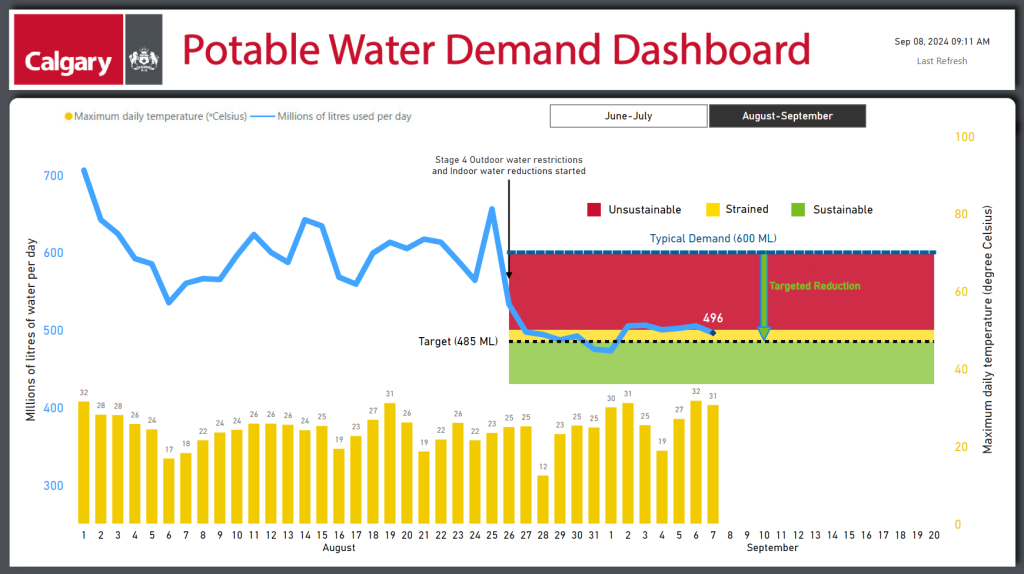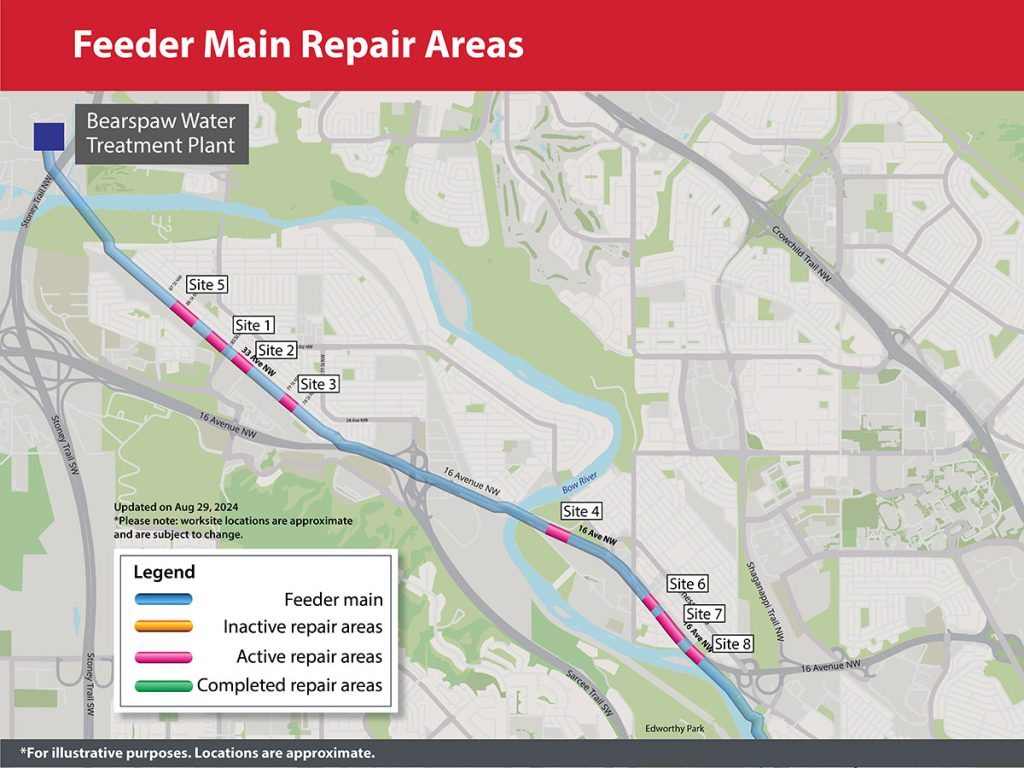Calgarians got closer to the city’s target for water use on Saturday, but officials are emphasizing the need to keep water use at safe levels due to a couple of issues over the weekend.
According to data from the city’s water use dashboard, 496 million litres were used on Saturday, down from 502 million litres on Friday.
Officials increased the target from 450 million litres to 485 million litres after crews tested a new configuration that let 35 million more litres safely move through the system.
Carolyn Bowen, director of climate and environment for the City of Calgary, says despite being in the “yellow zone” on the city’s Potable Water Demand Dashboard, which means a “strained” plant system, the city can replenish underground storage tanks and safeguard the Glenmore water treatment plant.
However, she says there was a pump failure and a malfunctioning component in the water treatment process over the last two days.

While crews were able to respond and address the concerns, Bowen says the incidents highlight the risks of maintaining high operational pressure over extended periods.
“So if you think of your car engine, it’s designed to drive at a range of consistent speeds which balance your RPMs, and when you need to increase your speed quickly, your engine revs and your RPMs increase. The engine is designed to maintain bursts of high revs and then go back to regular levels,” she explained.
“Our plants are similar, and when we stay above 500 million litres, we’re revving the engines at an unsustainable level over a prolonged period of time and risk overheating the system.”
She says staying in the “green zone” allows the city to continue to conduct necessary preventative maintenance to keep the plant running optimal water delivery to all Calgarians.
“When demand trends between 485 and 500 million litres, which is our yellow zone, the plant is working harder and preventative maintenance activities are more challenging to complete, increasing the risk of an operational failure,” Bowen said.
“When we enter the red zone above 500, we begin running the risk of not being able to keep up with the demand, and it starts becoming increasingly difficult to recover water storage in our underground storage tanks. And at this level, we’re not conducting preventative maintenance, and all maintenance activities are reactive.”
Reduced water use ‘strongly’ encouraged
The Glenmore Water Treatment Plant is currently producing 70 per cent of the city’s water supply, which is much higher than its normal 30 per cent at this time of year.
Bowen says steps must be taken to keep water use down, and adds the city is “actively engaged” with major industries and organizations to “implement water reduction strategies.”
Residents are continuing to be “strongly” encouraged to find new ways to reduce indoor and outdoor water use.
“Our focus is on maximizing voluntary conservation efforts to mitigate infrastructure risk and having to make any difficult decisions that have further impacts on Calgarians, businesses and city services,” she said.
Calgarians are being asked to use non-potable water sources like rain barrels, grey water, or river water. The latter can be picked up from one of the city’s three non-potable water pick up stations. The hours at these stations have been extended from 9 a.m. to 7 p.m. daily.
With Stage 4 outdoor water restrictions in place, calls to 311 on Saturday jumped to 1,273 residential, 262 commercial, and 115 multi-family violations. Tickets with fines of $3,000 have gone up to 26 from 22.
Calgarians who are seeing outdoor water misuse can provide information related to these instances through the Calgary 311 app or calgary.ca/311.
Construction remains on track for Sept. 23 timeline
Bowen says repairs are progressing well and remain on schedule.
Bowness Road is open in both directions, construction along 33 Avenue and Shouldice Park is progressing well, and repairs on sites one through four are complete.

This means 12 of the 21 pipe segments, which are 33 Avenue NW and Shouldice Park on sites one to four are repaired, and the city is now in the final stages of backfilling and paving to bring the road back into service.
For site five, the final site on 33 Avenue at 86 Street NW, excavation continues. She says one excavation is complete, while the other two continue.
The city says excavation is completed at three of the six segments at sites six to eight on 16 Avenue NW, and rebar materials have been installed at two sites in preparation for concrete pouring on Monday. Rebar is being installed at the other sites.

“We are making good progress and remain on schedule for these repairs,” Bowen said.
“And as we continue our repair work, we do ask that Calgarians be mindful of their speed to ensure the safety of the public and workers on site.”
Motorists are being reminded that 16 Avenue NW is closed from 46 Street to 41 Street, with traffic being detoured onto Bowness Road.
Due to Bowness Road being open in both directions, direct access to 16 Avenue and Bowness and Montgomery businesses are available, with Bowen adding they are “open for business.”
Water restrictions are expected to end on Sept. 23.